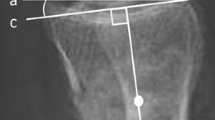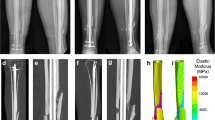Abstract
The aim of the study was to evaluate the potential of magnification radiography in diagnosing fracture healing and assessing its complications. Seventy-three patients with fractures or who had undergone osteotomy were radiographed with both conventional (non-magnified) and magnification (5-fold) techniques. Since 10 patients were radiographed twice and 1 three times, 83 radiographs using each technique were obtained. All radiographs were analysed and the findings correlated with the patients' follow-up studies. The microfocal X-ray unit used for magnification radiography had a focal spot size of 20–130 μm. As an imaging system, digital luminescence radiography was employed with magnification, while normal film-screen systems were used with conventional radiography. Manification radiography proved superior to conventional radiography in 47% of cases: endosteal and periosteal callus formations were sen earlier and better in 26 cases, and osseous union could be evaluated with greater certainty in 33 cases. In 49% of cases magnification radiography was equal and in 4% inferior to conventional radiography. Additionally an “inter-observer analysis” was carried out. Anatomical and pathological structures were classified into one of four grades. Results were significantly (P < 0.01) better using magnification radiography. We conclude that the magnification technique is a good method for monitoring fracture healing in its early stages.
Similar content being viewed by others
References
Young JW, Kostrubiak IS, Resnik CS, Paley D (1990) Sonographic evaluation of bone production at the distraction site in Ilizarov limb-lengthening procedures. AJR 154: 125–128
Giebel G (1993) Kallusdistraktion. In: Hierholzer G, Weller S (eds) Traumatologie aktuell, vol 5. Thieme, Stuttgart
Brug E, Winkler S (1991) Zurück zur Kallusheilung durch dynamisierbare Osteosyntheseverfahren. Radiologe 31: 165–171
Aro HT, Wippermann BW, Hodgson SF, Wahner HW, Lewallen DG, Chao EYS (1989) Prediction of properties of fracture callus by measurement of mineral density using micro-bone densitometry. J Bone Joint Surg [Am] 71: 1020–1030
Braunstein EM, Golstein SA, Ku J, Smith P, Matthews LS (1986) Computed tomography and plain radiography in experimental fracture healing. Skeletal Radiol15: 27–31
Schnarkowski P, Weidenmaier W, Mutschler W, Arand M (1992) Erste Erfahrungen zur Quantifizierung der Frakturheilung mittels Computertomographie. Röntgenpraxis45: 380–384
Nutz V, Uexktill-Guldenband V (1988) Computertomographische Untersuchungen der Frakturheilung. Fortschr Röntgenstr 149:396–401
Wallace AL, Strachan RK, Blane A, Best A, Hughes PF (1992) Quantitative early phase scintigraphy in the prediction of healing tibial fractures. Skeletal Radiol 21: 241–245
Hanneschläger G, Reschauer R (1990) Sonographische Verlaufskontrolle der sekundären Frakturheilung. Fortschr Röntgenstr 153: 113–119
Takahashi S, Sakuma S (1975) Magnification radiography. Springer, Berlin Heidelberg New York
Zimmer EA (1953) Die praktische Anwendung und die Ergebnisse der radiologischen Vergrösserungstechnik. Fortschr Röntgenstr 78: 164–169
Rao GUV, Soong AL (1973) Physical characteristics of modern microfocus X-ray tubes. AIR 111: 628–633
Sugiura Y (1958) Clinical application of enlargement radiography in orthopedic surgery: I. Nagoya J Med Sci 21: 333–338
Gebureck P, Fredow G, Sperner W (1991) Anlagenkonzept einer Mikrofokusröhre für die klinische Anwendung. Radiologe 31: 407–412
Kronholz H-L (1991) Direktradiographische Vergrösserung und Strahlenexposition. Radiologe 31: 413–417
Reuther G, Kronholz HL (1991) Direktradiographische Vergrösserung in Kombination mit digitaler Radiographie für die Skelettdiagnostik. (Direct radiological magnification with digital radiography for skeletal imaging.) Radiologe 31: 424–429
Müller ME, Allgöwer M, Schneider R, Willenegger H (1977) Manual der Osteosynthese. Springer, Berlin Heidelberg New York
McKibbin B (1978) The biology of fracture healing in long bones. J Bone Joint Surg [Br] 60: 150–162
Weissman BNW, Sledge CB (1986) Orthopedic radiology. Saunders, Philadelphia
Aegerter E, Kirkpatrick JA (1975) The repair of fractures. In: Orthopedic disease: physiology, pathology, radiology. Saunders, Philadelphia, chap 8
Heppenstall RB (1980) Fracture treatment and healing. Saunders, Philadelphia
McClements P, Templeton RW, Pritchard JJ (1961) Repair of a bone gap. J Ana 95: 616
Nicholls PJ, Berg E, Bliven FE, Kling M (1979) X-ray diagnosis of healing fractures in rabbits. Clin Orthop 142: 234–236
Müller-Miny H, Erlemann R, Baranowski D, Roos N, Peters PE (1991) Radiologische Beurteilung von Osteosynthesen. Radiologe 31: 179–185
Rosenthal H, Freier W, Galanski W (1991) Komplikationen der Osteosynthese im Röntgenbild. Radiologe 31: 186–191
Freyschmidt J, Fröhlich H, Rittmeyer K, Behrens S (1976) Neue Aspekte zur Vergrösserungstechnik in der chirurgischen Röntgendiagnostik. Arch Orthop Unfall-Chir 84: 67–76
Matsuda T (1955) Evaluation of direct enlargement radiography applied to the examination of the bone structure of adults. Studies on enlargement radiography. Nippon Acta Radiol 14: 767–774
Link TM, Gaubitz M, Lenzen H, Müller-Miny H, Schneider M, Peters PE (1993) Klinische Anwendung der Vergrösserungsradiographie bei rheumatologischen Fragestellungen. Z Rheumatol 52: 161–166
Tateno Y, Iinuma T, Takano M (1987) Computed radiography. Springer, Berlin Heidelberg New York
Lehmann KJ, Busch H-P, Sommer A, Georgi W (1991) Die Wertigkeit digitaler Bildaufnahmeverfahren bei der Skelettdiagnostik. Fortschr Röntgenstr 154: 286–291
Author information
Authors and Affiliations
Rights and permissions
About this article
Cite this article
Link, T.M., Kessler, T., Lange, T. et al. Fracture healing: direct magnification versus conventional radiography. Eur. Radiol. 4, 341–346 (1994). https://doi.org/10.1007/BF00599068
Received:
Revised:
Accepted:
Issue Date:
DOI: https://doi.org/10.1007/BF00599068




